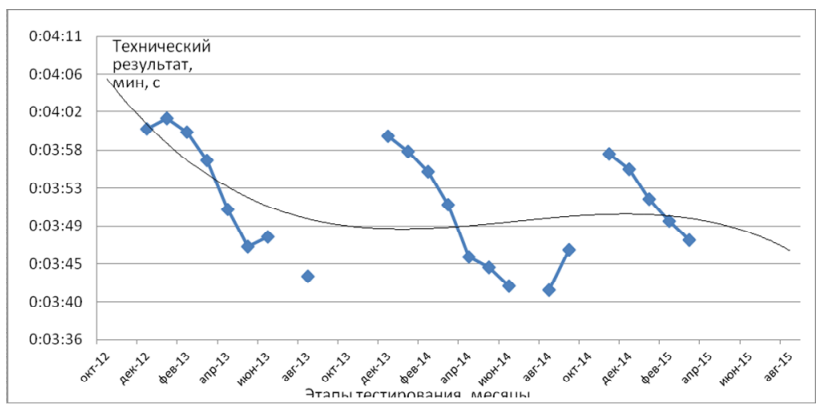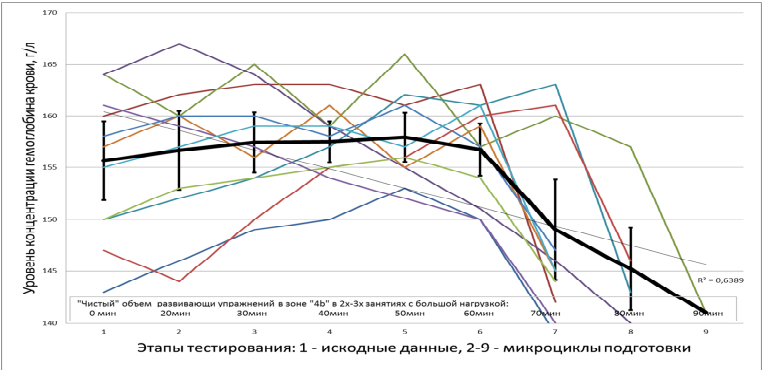Samuylenko Vytaly, Gatilova Galina, Eremenko Natalia, Beznosenko Aleksey, Sologub Ludmila Research Institute of the National University of Physical Education and Sport of Ukraine, Kiyv, Ukraine
Annotation. The problems associated with reaching the peak of sports form by rowers are shown. The features of the development of special endurance in the competitive period of the annual training cycle in rowing in kayaks were determined using the methods of radiotelemetric pulsometry, blood biochemistry, and statistical methods of data processing. A range of training methods and methods for testing the functional state of rowers, which have a positive effect on approaching the peak of sports form, have been determined. The necessity of using special exercises at competitive speeds, as well as taking into account the dynamics of blood hemoglobin concentration in the current control, has been proved.
Introduction. Training and competitive loads in rowing, which are high in volume and intensity, place special demands on the body of athletes [5]. At the same time, the analysis of the criteria for managing the process of sports training in kayaking and canoeing revealed shortcomings associated with insufficient understanding of the adaptation mechanisms and conditions for achieving a high sports result, including by highly qualified athletes [4]. The training process, in the conditions of today’s competition, should be associated with the use of modern methods of control, as well as with the most effective methods of sports training [4, 6, 7]. At this stage, a large number of approaches to testing the preparedness of qualified athletes are used, followed by interpretation of the data obtained to optimize the means and methods of further sports improvement. And only a part of them are informative and simple at the same time [1, 2, 3, 8, 9, 10]. At the same time, the pedagogical and biomedical assessment of the impact of loads on the body of athletes is of particular relevance, which provides information for the optimal dosing of work and rest [5, 9, 10]. This is of great importance in the development of special endurance in the competitive period of the annual training cycle, when the inadequacy of the use of training methods can lead to loss and illness [10, 11]. Methodology and organization of research. In the competitive period, 12 highly qualified rowers – kayakers aged from 21 to 29 (23.8+2.34) years old, with sports qualifications of MS and MSMK of Ukraine, were studied. A group of theoretical methods, Polar RS800 G3 radiotelemetric pulsometry, Excel methods of statistical data processing and analysis of training diaries of athletes Polar Pro Trainer, biochemical blood tests in terms of lactate concentration (operational control) and hemoglobin (current control) were widely used in the work. ) “Dr. Lange LP 420. This made it possible to establish the degree of influence of the glycolytic mechanism of energy supply on the indicators of sports performance, physiological efficiency, and health status [1, 2, 3, 9, 10]. Research results and discussion. Additional principles for building the training process in the competitive period of training qualified rowers in kayaks were identified, with the development of special endurance before the main competitions: – introducing an extrapolation method into the sports result planning system that allows you to set the level of the planned average distance speed of an athlete or crew in a given season (Figure 1 ); – increase in loads performed at the level of competitive speed in zone 4b above the anaerobic exchange threshold (ANOT) for the formation of special adaptive reactions at distances of 500 and 1000 m (Table 1); – use of the system of operational and current control of the training effect and load tolerance based on the system of “feedback” on the body’s internal reaction to the proposed physical load (Table 2, Figure 2). Based on the individual parameters of the planned competitive activity, a training program was proposed, aimed at increase in special endurance in relation to competitive distances (500 and 1000 m), with a complex effect on the result of athletes of loads from aerobic and anaerobic energy supply zones

Pic. 1. The polynomial curve of the dynamics of the sports result in a single kayak at 1000 m for athlete “A” in three macrocycles of training (three years) with extrapolation of functional capabilities to the main competitions of the current year
Table 1. Interpretation of load intensity zones in kayak and canoe rowing by heart rate and boat speed [10]

The experimental group was asked: 2 – 3 times a week special exercises lasting 20-70% of the competitive distance at a model distance speed. Rest intervals by the time of work and the number of segments in the series varied, provided that the set speed was maintained. The level of lactate concentration after a series of segments should not exceed the value by 4 – 6 mmol. l -1 less than the individual maximum (differentiated approach). The “net” volume for training was 3500 – 4500 m and more. If it was impossible to maintain these work parameters, as well as in the absence of heart rate recovery in the intervals between series, the load was stopped. As an option – an increase in rest intervals and / or a decrease in the length of the passable segment. Optimal examples of training session models are shown in Table 2.
Table 2. Optimal examples of training sessions aimed at developing special endurance in the competitive period of the annual training cycle for highly skilled kayakers

On the outer sides of the load, the rowing speed (operational control) and the volume of loads in minutes in zone 4b in the weekly training cycle (current control) were evaluated. Blood lactate concentration (operational control) and the level of hemoglobin concentration in blood (current control) were evaluated on the internal sides of the load. Registration of heart rate – as an auxiliary method. As a result of the pedagogical experiment, it was found that the athletes of the experimental group, in whose training process the proposed program for increasing special endurance and monitoring the operational and current state was harmoniously introduced, had a greater increase in the result at a distance of 500 and 1000 m to the main competitions of the season than representatives of the control group. (Table 3). At the same time, for each athlete, the volume of training loads in zone 4b in the allotment cycle of training was established, above which further intensification led to a significant decrease in the concentration of hemoglobin in the blood, and, consequently, to a decrease in aerobic productivity and, in the future, the level of health.

Pic. 2. Dynamics of hemoglobin content in arterial blood during the competitive period of training in twelve highly skilled kayakers of the experimental group with an increase in training loads in zone 4b from microcycle to microcycle to the main competitions of the season (1 – initial data, 2 – 9 – eight weekly training microcycles)
The total amount of work performed in training not only did not have high correlations with sports results, but vice versa – it counteracted it. The optimal amount of training work in zone 4b (Figure 2) according to the averaged data was up to 60 minutes of pure work in a weekly training cycle. At the same time, the quality of rest, nutrition, physiotherapeutic rehabilitation procedures were of great importance, the optimal use of which could contribute to a slight increase in the volume of performed loads in zone 4b. The biggest mistakes in the development of special endurance in the competitive period of the annual training cycle among highly skilled kayakers of the control group was the use of exercises in zone 4a (including those with hydraulic brakes), leading to the formation of a speed barrier. Another mistake is overusing the 4c zone to increase the athlete’s ability to counteract fatigue from excess lactate accumulation, as opposed to training to increase the rate of lactate utilization from working muscles during exercise at distance speed.
Table 3. Dynamics of sports results at distances of 500 and 1000 meters in the experimental and control groups of qualified kayakers before the main competitions of the season for 8 seven-day microcycles of training

The given dynamics of the sports result and the reaction of the body of athletes to the proposed physical activity were revealed in the canoe and women’s kayak groups. Features of the course of adaptation of these athletes to the implementation of such training programs will be published separately.
Conclusions:
- A training method has been determined that significantly improves the rate of increase in sports results in preparation for the main competitions of the year, relative to traditional ideas. This method is “creating a motor stereotype at distance speeds” with two or three training sessions in a weekly training cycle (using large and significant loads, respectively).
- It has been determined that the optimal volume of training loads at the planned competitive speed in a weekly training cycle for highly skilled kayakers is in the region of 50-60 minutes of “pure” work time. However, this volume is strictly individual and must be controlled by biochemical testing methods in the current control (once a week, after a day of rest).
- The best method for controlling the tolerance of training loads at competitive speeds, which has proven itself in these studies, was to take into account the dynamics of blood hemoglobin – weekly, after a day of rest. With a significant decrease in the blood hemoglobin concentration in a particular athlete, training loads at competitive speeds return to volumes that do not cause such a negative reaction.
Literature:
- Gatilova G.D. (2009) Features of realization of anaerobic and aerobic abilities of qualified canoeists at Olympic competitive distances. Journal: Science in Olympic Sports. Kyiv: Olympic Literature. No. 1. pp. 148 – 153.
- Golberg N.D., Morozov V.I., Rogozkin V.A. (2001) Metabolic reactions of the body during adaptation to muscle activity. Mol. biology. V. 78. P. 481 – 492.
- Levin R.Ya., Nour A.M., Siversky E.M. (1996) The use of pulsometry in the training of high-class athletes. Kyiv: GNIIFKiS. 80 s.
- Mishchenko V.S. (1997) Physiological monitoring of sports training: modern approaches and directions of improvement. Science in Olympic sports. Kyiv: Olympic Literature. No. 1 (6).
- Platonov V.N. (2004) The system of training athletes in Olympic sports. Kyiv: Olympic Literature. pp. 129-131, 167-203, 422-440.
- Shephard R. (1992) General consultations. Biolog bases of Endurance. Endurance in sport. Oxford: Blackwell scientist. Publ. P. 21-32.
- Wilmore J.H. (1992) Body composition and Body Energy Stores. Endurance in Sport. Blackwell Scientific Publications. P. 244 – 255.
- Yoshida T., Chida M., Masaniko I. (1987) Blood lactate parameters related to aerobic capacity and performance. Europe Jur. of Appl. Physiol. V. 56. P. 7 – 11.
- Samuylenko V.E. Features of the development of special endurance of qualified canoe rowers in the preparatory period of the annual training cycle: http://cuadr.at.ua/publ/vesluvalnij_sport_canoeing_grebnoj_sport/2-1-0-14 10. Samuylenko V.E. Normalization of the intensity of training loads of qualified rowers in kayaks and canoes: http://cuadr.at.ua/publ/vesluvalnij_sport_canoeing_grebnoj_sport/normirovanie_intensivnosti_trenirovochny kh_nagruzok_kvalificirovannykh_grebcov_na_bajdarkakh_i_kanoeh/2-1-0-7 11. Samuylenko V. P., E. Yeremenko L. N. (2014) Modeling the passage of competitive distances by qualified rowers in kayaks and canoes (on the example of men’s rowing in kayaks). Bulletin of the Chernigiv National Pedagogical University. Ser.: Pedagogical sciences. Physical development and sport. No. 118(4). pp. 188-191.